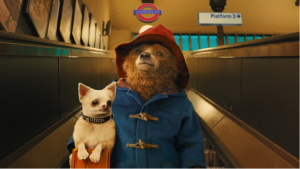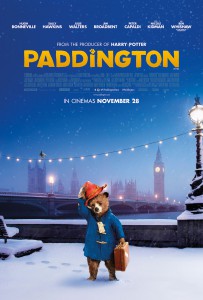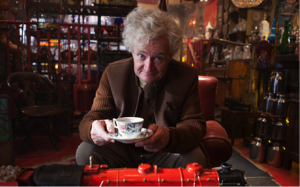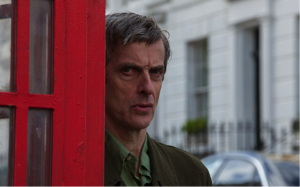A Very British Migrant Crisis: Paddington and the Children’s Film
Post by Lincoln Geraghty, University of Portsmouth
This post continues the ongoing “From Nottingham and Beyond” series, with contributions from faculty and alumni of the University of Nottingham’s Department of Culture, Film and Media. This week’s contributor, Lincoln Geraghty, completed his PhD in the department in 2005.
 The recent national media coverage of a very international problem that news broadcasters around the world have termed the “migrant crisis” has highlighted Britain’s conflicting and problematic attitude towards immigration. The words “foreigner,” “other,” or “outsider” have been used in the press as a means by which politicians can lay claim to protecting British interests and sealing off British borders. Alongside the rush not to aid fellow European nations by taking a fair share of refugees lies an increasing amount of euroskepticism that characterized much of the debate about the UK’s relationship with Europe during the 2015 parliamentary election. Campaigns by the three main parties and those such as the UK Independence Party all professed that immigration was a problem they alone could fix. Indeed, this past week has seen lines drawn in the battle to convince Britons to vote “Yes” or “No” in 2017’s promised referendum on whether the UK should leave the EU. Those supporting the “Yes” campaign would more than likely say Britain should not allow Europe to dictate immigration policy. Nonetheless, notwithstanding the EU referendum, Britain has continued to remain aloof rather than cooperate with other European nations such as France and Germany to solve common problems. Determined to take advantage of its island status, it distances itself from the fact the country remains an attractive draw to thousands of migrants who wish for a better life in the UK.
The recent national media coverage of a very international problem that news broadcasters around the world have termed the “migrant crisis” has highlighted Britain’s conflicting and problematic attitude towards immigration. The words “foreigner,” “other,” or “outsider” have been used in the press as a means by which politicians can lay claim to protecting British interests and sealing off British borders. Alongside the rush not to aid fellow European nations by taking a fair share of refugees lies an increasing amount of euroskepticism that characterized much of the debate about the UK’s relationship with Europe during the 2015 parliamentary election. Campaigns by the three main parties and those such as the UK Independence Party all professed that immigration was a problem they alone could fix. Indeed, this past week has seen lines drawn in the battle to convince Britons to vote “Yes” or “No” in 2017’s promised referendum on whether the UK should leave the EU. Those supporting the “Yes” campaign would more than likely say Britain should not allow Europe to dictate immigration policy. Nonetheless, notwithstanding the EU referendum, Britain has continued to remain aloof rather than cooperate with other European nations such as France and Germany to solve common problems. Determined to take advantage of its island status, it distances itself from the fact the country remains an attractive draw to thousands of migrants who wish for a better life in the UK.
It is with all that said that I recently watched the British children’s film Paddington (2014). In many ways it is a film all about immigration–after all, Paddington arrives in the UK hoping to find a place to live after his own home is left devastated by natural disaster.  As a stranger in stranger land, Paddington enjoys a wide-eyed innocence when confronted with prejudice and suspicion. But despite initial fears of this animal “other,” Britain, or more specifically England, represents a utopia–a land of plenty (especially marmalade sandwiches)–where Paddington feels at home and his adopted family feels at home with him. With immigration and the migrant crisis so prevalent in the press today, it seems easy to think that we are only now engaging with the issues that make it such a divisive topic. However, judging by the content of Paddington, how as a children’s film it tackles quite adult themes of otherness and displacement and the fact that the original books were published in the 1950s, it would seem that the figure of the migrant and the idea of Britain as safe haven for immigrants have existed in children’s literature and popular culture for decades. Indeed, using children’s film as a platform for discussing such issues suggests that the genre has had a history of dealing with real-world social problems, of which we should be taking greater account when studying the film industry in its contexts.
As a stranger in stranger land, Paddington enjoys a wide-eyed innocence when confronted with prejudice and suspicion. But despite initial fears of this animal “other,” Britain, or more specifically England, represents a utopia–a land of plenty (especially marmalade sandwiches)–where Paddington feels at home and his adopted family feels at home with him. With immigration and the migrant crisis so prevalent in the press today, it seems easy to think that we are only now engaging with the issues that make it such a divisive topic. However, judging by the content of Paddington, how as a children’s film it tackles quite adult themes of otherness and displacement and the fact that the original books were published in the 1950s, it would seem that the figure of the migrant and the idea of Britain as safe haven for immigrants have existed in children’s literature and popular culture for decades. Indeed, using children’s film as a platform for discussing such issues suggests that the genre has had a history of dealing with real-world social problems, of which we should be taking greater account when studying the film industry in its contexts.
Written and directed by Britain’s Paul King, the film was made by the UK’s Heyday Films, the same company that produced the Harry Potter series, and France’s StudioCanal. Based on Michael Bond’s famous English series of children’s books, the film was adapted for an international audience, casting popular and renowned UK actors such as Hugh Bonneville, Julie Walters, Jim Broadbent and Peter Capaldi alongside Australian American Nicole Kidman. For its modest $55 million budget it made $258.6 million at the box office. Its main star, of course, is the CGI Paddington Bear–voiced by UK actor Ben Whishaw (who replaced Oscar winner Colin Firth late in the production)–and it is through Paddington that we are introduced to the Brown family and the eccentricities of British society and culture.
 Paddington is befriended by Mr. Gruber (Jim Broadbent, above), who is also an immigrant, having fled Hungary as a child during World War Two to escape the Nazis. Both see London as a utopic space, a place to escape the hardships of their respective homelands. In the film, Mr. Gruber runs an antique shop in Portobello Road and Paddington visits to help investigate the identity of the explorer who came to Peru all those years ago. A scene combining live action and animation allows Mr. Gruber to talk about his childhood when he came to London to escape the war. This strikes a chord with Paddington, who himself is awestruck with wonder at all the items on display in the store. Mr. Gruber treats Paddington with respect, is interested in his stories about the explorer, and sees the bear as wise beyond his young years. Paddington’s youthful energy rubs off on Mr. Gruber, and the pair feel a sense of kinship.
Paddington is befriended by Mr. Gruber (Jim Broadbent, above), who is also an immigrant, having fled Hungary as a child during World War Two to escape the Nazis. Both see London as a utopic space, a place to escape the hardships of their respective homelands. In the film, Mr. Gruber runs an antique shop in Portobello Road and Paddington visits to help investigate the identity of the explorer who came to Peru all those years ago. A scene combining live action and animation allows Mr. Gruber to talk about his childhood when he came to London to escape the war. This strikes a chord with Paddington, who himself is awestruck with wonder at all the items on display in the store. Mr. Gruber treats Paddington with respect, is interested in his stories about the explorer, and sees the bear as wise beyond his young years. Paddington’s youthful energy rubs off on Mr. Gruber, and the pair feel a sense of kinship.

Unlike Gruber, the mean and miserly old man next door, Mr. Curry, is not fond of Paddington. Played by Peter Capaldi, who was cast in 2013 as The Doctor on Doctor Who, Mr. Curry is depicted as a lonely bachelor. His hatred of Paddington could be viewed as xenophobic–an illegal alien from South America living in the privileged surroundings of West London’s Notting Hill–and I would argue is meant to resonate with British audiences as reference to contemporary political debates concerning immigration prevalent in the UK during the run-up to the General Election and the rise of UKIP. Indeed, Kyle Grayson argues of the original books that they illustrate “how political theorising may take place in the vernacular space of popular culture” and that the figure of Paddington as immigrant works to unpack “liberal conceptions of identity, migration and tolerance while drawing attention to specific negotiations of difference.[1] Similarly, Angela Smith maintains that while the stories “are subtle in their articulation of racist and xenophobic discourses which […] present the case for toleration and understanding towards immigrants,” Paddington has to try to fit in just as “the immigrant conforms to the dominant culture’s norms.”[2] Therefore, the film replicates the books in the representation of Paddington as a non-threatening other who eventually wins over Mr. Curry and proves his worth to his adopted family, the Browns, by bringing the family together.
Both Paddington and Mr. Gruber’s search for a new place to call home can be considered nostalgic. This desire for a home is the epitome of nostalgia, whose rhetoric and experience is framed by a feeling of absence and longing: what Susan Stewart says “leads to a generalized desire for origin, for nature, and for unmediated experience.”[3] Nostalgia is also linked with nation, and in Paddington we can see this connection in London’s representation through icons and stereotypes of Englishness: red double-decker buses, soldiers in front of Buckingham Palace, red telephone boxes, the English “bobby” policeman, rain, the city skyline (featuring, for example, the House of Parliament), tea and tea drinking, English reserve and manners, Mr. Brown’s stiff upper lip, and a host of other tropes throughout the movie. Indeed, for Margaret Meek in her study of English children’s literature, nostalgia is a “thread” in the “texture of Englishness.”[4] Thinking about the marketing of the international family film genre, the prominence of familiar icons of England and Englishness can be understood as part of the translation of an English children’s story for an international audience–relying on well-known tourist images of the country to brand the film as English, and using cultural stereotypes to add humor and to emphasize Paddington’s identity as stranger in a strange land. However, more importantly, their use within the narrative exaggerates the sense of nostalgia that both Paddington and Gruber feel for home. It is perhaps the incessantness, their constant flagging (to borrow Michael Billig’s term) as symbols of English nationhood and identity throughout the film’s emotional high points, which in the end transforms the exiles (the bear child and old man) into adopted nationals–assimilated immigrants in a narrative of nostalgia, family and nation.
Children and old people are important components of nationhood. Such emphases in the film make it stand out as a relevant text through which we might understand media fascination for, and problematic coverage of, the “migrant crisis.” In addition, as a children’s film it highlights that from a very early age, young audiences are being introduced to topics that will no doubt resonate when they get older and are able to participate in debates surrounding Britain’s relationship with Europe and the wider world. As a British film in 2014, when the country was bombarded by newspapers and politicians asking us to listen to them and trust their views on important issues such as immigration, it perhaps even more importantly questions the underlying ideologies at the heart of the media we consume and the childhood characters with whom we have grown up.
Notes
[1] Kyle Grayson, “How to Read Paddington Bear: Liberalism and the Foreign Subject in A Bear Called Paddington,” The British Journal of Politics and International Relations 15.3 (2013), p. 391, p. 378.
[2] Angela Smith, “Paddington Bear: A Case Study of Immigration and Otherness.,” Children’s Literature in Education 37.1 (2006), p. 48.
[3] Susan Stewart, On Longing: Narratives of the Miniature, the Gigantic, the Souvenir, the Collection (Durham: Duke University Press, 2007), p. 24.
[4] Margaret Meek, “The Englishness of English Children’s Books,” Children’s Literature and National Identity, ed. Margaret Meek (Stoke in Trent: Trentham Books, 2001), p. 96.


